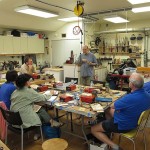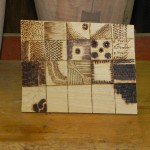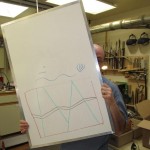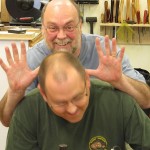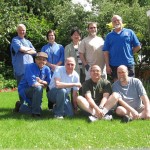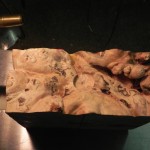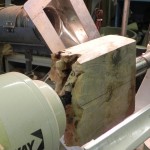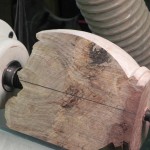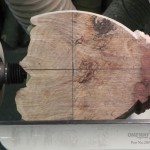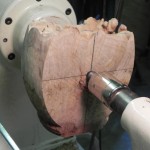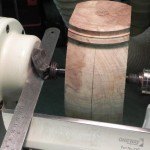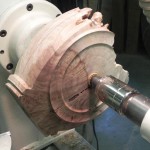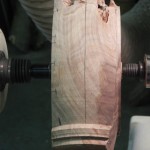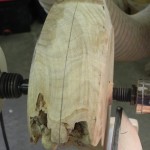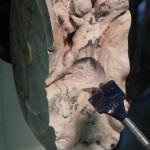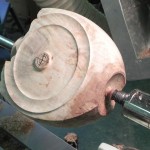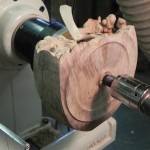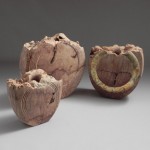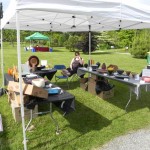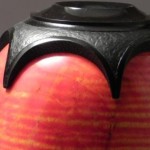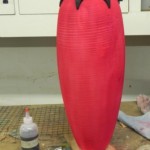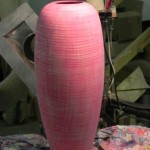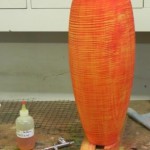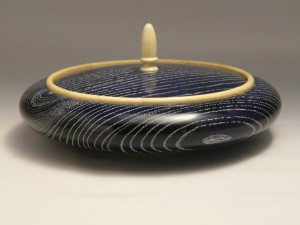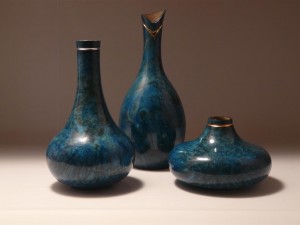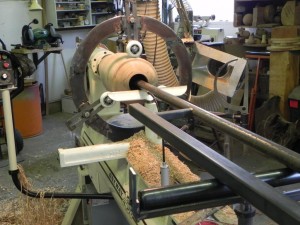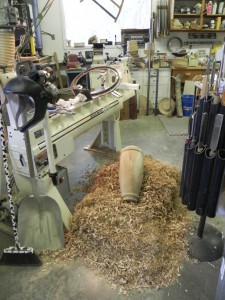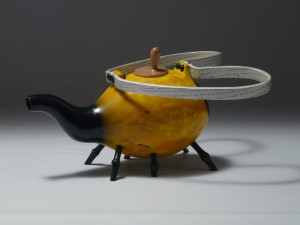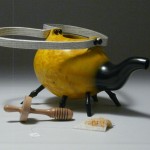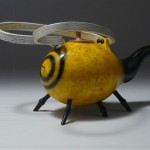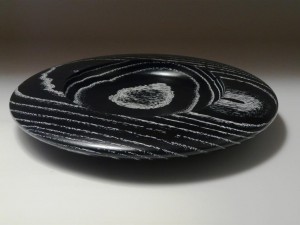
A Black Tie Affair. Painted oak with lime wax
Recently I have received requests from a few other turners for tips on using lime wax. There’s not a lot of literature on the process that I am aware of except a book that I have myself; “Colouring Techniques for Woodturners” by Jan Sanders. I picked the book up about 12 years ago from Lee Valley and I believe they still sell it. For me it has been an excellent resource and motivator for the treatment of wood post-turning. Because I seem to be getting more calls and emails about liming recently I thought I would write a post about it so I could simply direct folks to this site – so if sent you, “Welcome”. If I didn’t, “Welcome”. 🙂
For the purpose of this explanation I will use the terms “lime wax” or “liming” for simplicity. In truth, it is possible to apply all kinds of colours of wax that aren’t white and I usually refer to them as “tint waxes” for clarity, but the process is the same. Also, lime wax isn’t really wax, but rather some kind of very fine powder (I don’t think it’s lime, but rather some kind of oxide) in an oil base while coloured waxes are actually wax with colour added.
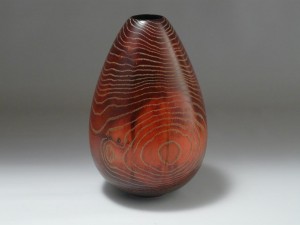
- Gypsy Queen. Dyed elm with gold tint wax.
To start off with, my approach to colouringwood is something that I do to emphasise grain characteristics such as the figure in wood or perhaps grain lines that naturally have significant contrast (sap wood and heart wood, for example) or just to get away from a bland brown (contrary to popular belief, I don’t think all wood is bland). Although the wood may be coloured, liming is used to emphasizes grain direction and pattern. “Gypsy Queen” is an example where both dying and liming are used to enhance both a grain characteristic and grain pattern. The process requires a ring-porous wood for best effect. Ring-porous wood is wood that has the pores isolated into rings rather than dispersed throughout the wood as does diffuse-porous wood. The rings of pores, once treated with a contrasting tint or lime wax, stand out and become the focal point of the piece. Ring-porous woods include ash, oak, elm, hickory, chestnut. I’m sure there are more but these are all species that I have used successfully. In such cases as “Black Tie Affair” I have eliminated the colour of the wood entirely, making the grain lines the dominant feature of the piece. In some I have coloured the wood with dye, keeping the nature of the grain intact but added contrasting or complimenting tint wax for accent. Still others, I have not coloured the wood at all but used black wax to enhance the grain.
None of this is effective at all on diffuse-porous wood. I once tried to use lime wax on black walnut, thinking the contrast might look good. Walnut has zillions of little fissures throughout the wood. All it did was make the piece look messy and totally ruined it. So… no diffuse-porous wood, Grasshopper.
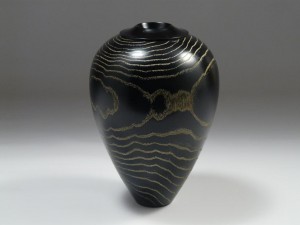
Midas. Painted Elm with gold tint wax.
The order of business for liming is to turn the piece, finish sand, open the grain, apply a finish and then apply the lime wax. It’s important that all the steps in this procedure are followed and that each is attended to with great detail. First: turning and sanding. Any anomalies in the turning will stand out like a sore thumb. In the same way that grain lines are emphasized, so is tear out and undesirable marks from poor tool control. Sanding is critical and if any dye is applied that will raise the grain, I always raise the grain first then resand prior to using the dye so that doesn’t cause a problem later. Opening the grain is a key step that you probably haven’t done before in other finishes. Using a small brass brush (or very vigorous work with a stiff plastic brush), thoroughly follow every grain line, brushing all bits if sanding dust and wood fibers from the pores. If you miss any it will be like a neon bald patch when it is way too late to do anything about it. You will notice that there is an incredible amount of debris removed from the pores if you put a piece of white paper under your work. If you are going to colour the wood, now is when you apply dye or paint. You will notice that not even dye penetrates the pores because of the surface tension of the liquid. If using paint, spray rather than brush it on. I prefer lacquer – mostly because that’s all I’ve used – so other bases may be OK but you will have to experiment on your own.
There seems to be a misunderstanding that the procedure is to apply the lime wax before putting any finish on the piece. Do not apply lime wax before finishing. If you do there will be no opportunity to apply any further finish, but most critically, if you have applied a dye and it has not been sealed with a finish, the lime wax will pull the colour into it and you won’t get the shocking white contrast, just a tint of the colour that you applied. I know because I did that my first time.
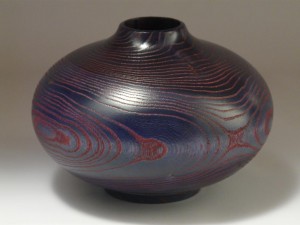
Outer Planet. Dyed elm with red tint wax.
So you have the piece turned, sanded, pores opened and colour applied. Some have been hesitant to apply the finish before waxing thinking that the pores would be sealed up and unable to accept wax. Nothing could be further from the truth. When the finish is applied it actually makes the pores deeper and wider but still leaves a “key” at the bottom. The trick is to stop before the pores get “round bottomed” so that the wax won’t key into it. After finishing a couple of pieces you get to know what to look for. If you don’t believe that the pores remain during finishing, think about any time you tried to finish a piece with deep grain pores and tried to fill them with finish. The same thing happens here only it’s a good thing. Understand that a rough finish like deep orange peel or simple roughness due to too much thinner will retain the wax and the result is very unattractive. If you have orange peel or roughness, sand it back before you get too many coats and finish off with a good last coat.
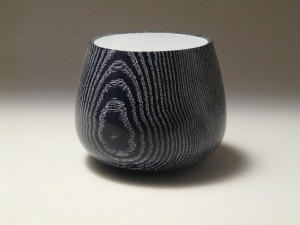
Untitled. Dyed (yes, it's blue dye) chestnut with lime wax.
Once the finish is complete it’s time to apply the lime wax. Follow the instructions! Wax on – wax off. Leave it on for only a few minutes like you would your car. If you wait too long it is very hard to remove the excess. Remove excess lime wax with neutral wax and you’re done. Liberon of course recommends their clear furniture wax but I have used all kinds and even neutral shoe polish works well.
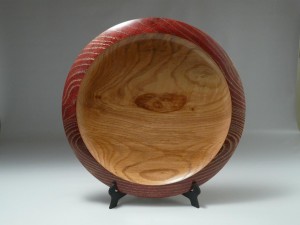
Storm Brewing. Dyed oak with gold tint. Note that you have to be prepared to live with cracks (about 4 o'clock)
I have been asked where to get some of the supplies for lime waxing. Lime wax itself is made by Liberon and available through Craft Supply and Woodchuckers. They also make a gilded tint wax as I recall. I use coloured wax that I got at a shoe repair store. I bought gold, silver, red, blue and yellow (metallics and primary colours). Black shoe polish works great for, of all things, black. 🙂 I have spoken to a turner who used white shoe polish as a substitute for lime wax although I am not sure he used wax or the paint-on type used for the old saddle shoes. His piece looked very nice but you’re on your own for that one. I have also experimented with paint as a tint but not enough to comment on it here. The brass brushes are available at paint stores. They look like brass tooth brushes. I have used a brush that I got at the grocery store that had plastic and brass bristles; it worked very well but I had to work pretty hard to get what I wanted.
Good luck and have fun. As you can see, liming gets a bit addicting, so be careful.
As always, I encourage your comments and questions, so please refer to the tag line at the bottom of the article to post a comment.

